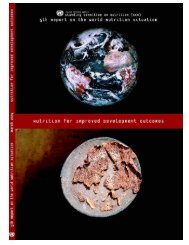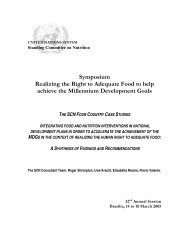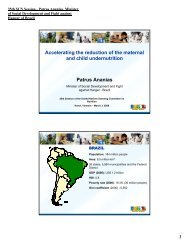Universal Salt Iodization (USI) - FTP Directory Listing
Universal Salt Iodization (USI) - FTP Directory Listing
Universal Salt Iodization (USI) - FTP Directory Listing
- No tags were found...
You also want an ePaper? Increase the reach of your titles
YUMPU automatically turns print PDFs into web optimized ePapers that Google loves.
58FEATURESwww.unsystem.org/scnComments from the SCN News <strong>USI</strong> peer review teamThe ten articles focusing on <strong>Universal</strong> <strong>Salt</strong> <strong>Iodization</strong> (<strong>USI</strong>) included in this SCN News were peer reviewed bymembers of the team listed below. There are a number of important policy and programme lessons that thepeer review team wishes to share, which they feel are relevant to the broader nutrition agenda of acceleratingthe transfer of scientific knowledge into practice. These go beyond those referred to by Venkatesh Mannar inhis editorial overview.The first lesson is about following due process in order to create policy leverage at the national level. The importanceof the normative voice of the World Health Organization at the country level was clearly understood bythe architects of <strong>USI</strong>. As discussed in the papers by Hetzel and Gautam, the World Health Assembly was usedto pass resolutions which pushed for the virtual elimination of IDD and for <strong>USI</strong>. The channel used to prepare theground for these resolutions was the WHO/UNICEF joint committee of the health policy as mentioned by Hetzel.The SCN Working Group on IDD helped provide the space where the multiple actors (UN agencies, bilateralpartners and non-government civil society actors) could contribute to the design, articulation and ongoingrefinement of the IDD/<strong>USI</strong> strategy during the period 1994 to 2000.The second lesson concerns the need to set standards beyond just preventing gross clinical deficiency. Prior to1990, for a country to be considered to have an IDD problem a survey was needed to show the presence ofgoitre in school children. As the science evolved however, it became clear that Hetzel’s spectrum of IDD wasnot only affecting populations which had individuals with visible goitres. Sub-clinical deficiencies, such as inadequatethyroid stimulating hormone (TSH) levels, affect newborns even in populations with no visible goitres.This realization led to the switching of goals from the virtual elimination of IDD as declared at the World Summitfor Children in 1990 to <strong>USI</strong> of the WHA resolution in 1994 that became the goal at the UNGASS in 2002.The third lesson is about making states responsible for achieving nutrition goals. Passing WHA resolutions forIDD and <strong>USI</strong>, as well as the WSC IDD elimination goal and the UNGASS <strong>USI</strong> goal has allowed the countrylevel local champions and the extended network of supporters and facilitators including the UN agencies, tofollow up with the national governments and ministries of health to push for action to get salt iodized. Althoughthe role of the private sector is essential for getting the job done, as has been described in the paper of deJong, the stewardship function of national governments is still critically important, as Haxton alludes to in hispaper. While the examples of China and Nigeria described by Akunyili and Chen et al in their papers are goodones, there are many other nation states that still have to step up to the plate and shoulder these responsibilities.These include some large and relatively more developed countries such as India, Korea and Pakistan forexample, with only 57%, 40% and 17% respectively of their household salt adequately iodized.The fourth lesson is the importance of continuous monitoring and feedback of <strong>USI</strong> and IDD programmes in allcountries. The use of varying levels of sophistication in monitoring the adequacy of national IDD mechanisms iswell covered in the paper by Sullivan et al. This is not only a developing country issue but one that all countrieshave to pay attention to. Evidence of continuing hypothyroidism in Switzerland in the late eighties for example,led to the levels of iodine in salt being raised in the early nineties, which successfully resolved the problem.The fifth lesson is that not all nutrition policy is necessarily based on a hard bed of evidence derived from randomizedcontrolled trials. Evidence for the efficacy of salt iodization still doesn’t exist*, and yet it is the mostwidely adopted of food fortification measures. The evidence for the effectiveness of salt iodization has beenbuilt out of the continuous monitoring and evaluation of large scale national salt iodization programmes. Fortunately,as can be verified by searching on Pub Med, still today a plethora of scientific studies is being publishedchecking whether <strong>USI</strong> programmes are working as they should be and further refining the population indicatorof optimal iodine status.Lucie Bohac (Iodine Network), Tina van den Briel (WFP), Ian Darnton-Hill (UNICEF), Regina Moench-Pfanner (GAIN),Roger Shrimpton (SCN), Juliawati Untoro (UNICEF)* Clar C, Wu T, Liu G and Li P (2002) Iodized salt for iodine deficiency disorders. A systematic review. Endocrinol MetabClin North Am 31(3):681-98.SCN NEWS # 35 back to contents







